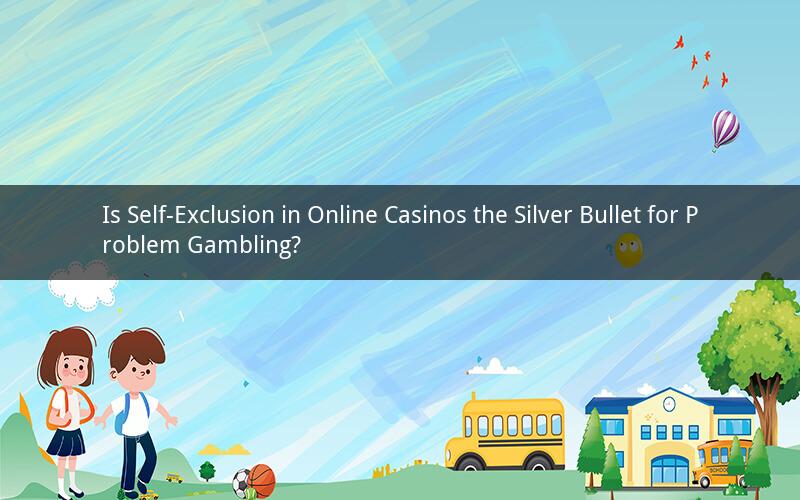
Table of Contents
1. Understanding Online Casino Self-Exclusion
2. The Evolution of Self-Exclusion Policies
3. Comparing Online and Land-Based Casino Self-Exclusion
4. Case Studies: Success and Challenges of Self-Exclusion
5. The Role of Technology in Self-Exclusion
6. Psychological Aspects of Self-Exclusion
7. Legal and Ethical Considerations
8. Public Perception and Feedback
9. Interactive Element: A Day in the Life of a Self-Excluded Gambler
10. Conclusion
---
1. Understanding Online Casino Self-Exclusion
In the digital age, the allure of online casinos has grown exponentially, offering convenience and a vast array of games at the fingertips of millions. However, this convenience has also given rise to a pressing concern: problem gambling. To combat this, many online casinos have implemented self-exclusion programs, allowing individuals to block themselves from accessing gambling sites. But is this the silver bullet that gambling authorities and addiction experts have been searching for?
2. The Evolution of Self-Exclusion Policies
Self-exclusion policies have evolved significantly since their inception. Initially, they were limited to land-based casinos, where individuals could sign a document vowing not to enter the premises. With the advent of online gambling, these policies had to adapt to the digital realm. Today, self-exclusion in online casinos involves a range of measures, from simple account locks to more sophisticated technological solutions.
3. Comparing Online and Land-Based Casino Self-Exclusion
While the core principle remains the same, there are notable differences between self-exclusion in online and land-based casinos. Online self-exclusion is often more accessible, as individuals can enroll in the program from the comfort of their homes. However, it also poses challenges, such as the potential for individuals to circumvent the restrictions by using alternative devices or accounts. Land-based casinos, on the other hand, offer a more tangible experience, but the self-exclusion process may be less transparent.
4. Case Studies: Success and Challenges of Self-Exclusion
Several case studies have highlighted the effectiveness of self-exclusion programs. For instance, a study by the UK Gambling Commission found that self-exclusion significantly reduced the frequency of gambling sessions among participants. However, challenges remain, such as the difficulty of enforcing self-exclusion across multiple platforms and the potential for individuals to lie about their identities.
5. The Role of Technology in Self-Exclusion
Technology plays a crucial role in the effectiveness of self-exclusion programs. From biometric identification to advanced algorithms that detect patterns of problem gambling, technology offers a powerful tool for monitoring and enforcing self-exclusion. However, the reliance on technology also raises concerns about privacy and data security.
6. Psychological Aspects of Self-Exclusion
The psychological impact of self-exclusion is a critical aspect often overlooked. While it can be a lifesaver for some, it can also lead to feelings of isolation and guilt. Experts suggest that a holistic approach, combining self-exclusion with therapy and support groups, is more effective in addressing the underlying issues of problem gambling.
7. Legal and Ethical Considerations
The legal and ethical implications of self-exclusion are complex. On one hand, it is a necessary measure to protect individuals from the harmful consequences of gambling. On the other hand, it raises questions about privacy, consent, and the potential for abuse. Striking the right balance is a delicate task for regulators and operators.
8. Public Perception and Feedback
Public perception of self-exclusion varies widely. While some view it as a vital tool in the fight against problem gambling, others argue that it is too simplistic and fails to address the root causes. Feedback from individuals who have enrolled in self-exclusion programs is mixed, with some reporting success and others expressing frustration.
9. Interactive Element: A Day in the Life of a Self-Excluded Gambler
Imagine a day in the life of a self-excluded gambler. Waking up to the realization that they have made a commitment to change, they navigate through their day, constantly reminded of their decision. They face temptation at every turn, from advertisements to social media posts. The struggle is real, and the support of friends, family, and professionals becomes increasingly important.
10. Conclusion
Is self-exclusion in online casinos the silver bullet for problem gambling? While it is a valuable tool, it is not a standalone solution. A combination of self-exclusion, therapy, support groups, and education is needed to address the complex issue of problem gambling. As technology continues to evolve, so too will the strategies used to combat this growing concern.
---
Questions and Answers
Q1: What are the main benefits of self-exclusion in online casinos?
A1: The main benefits include reducing access to gambling sites, providing a clear boundary for individuals struggling with problem gambling, and offering a sense of control and commitment to change.
Q2: Can self-exclusion be enforced across multiple platforms?
A2: Enforcing self-exclusion across multiple platforms is challenging but possible with the help of technology and collaboration between operators.
Q3: How can self-exclusion be combined with therapy for better results?
A3: Self-exclusion can be combined with therapy by providing individuals with the tools and support needed to address the psychological aspects of problem gambling.
Q4: What are the ethical concerns surrounding self-exclusion?
A4: Ethical concerns include privacy violations, the potential for abuse, and the responsibility of operators to ensure the effectiveness of self-exclusion programs.
Q5: How can the public be educated about the importance of self-exclusion?
A5: Public education can be achieved through awareness campaigns, social media, and collaboration with mental health organizations to promote understanding and acceptance of self-exclusion.